- Home
- Andrew McGahan
The Rich Man’s House Page 5
The Rich Man’s House Read online
Page 5
Okay now? Rita turned her head a moment, to take in the view along the river. It was an unremarkable scene, a tamed waterway in a tamed valley, people strolling along its bank in the sunshine. Ah, but to her old self … to her old self it would have looked very different. Her old self would have seen through the surface to the secret beneath.
This landscape, the whole western half of Melbourne, seemed to a casual observer to stretch out flat and bare and dusty: dull when compared to the eastern side of town, which rose, hilly and green, to meet the Dandenong ranges. But the flatness was a lie. In truth, the Maribyrnong River and its tributaries cut the plain into a maze of valleys and gorges. Freeways bridged those gorges heedlessly, but to a walker like Rita, following the minor roads and the bike tracks and the green belts, the western suburbs were a constant series of surprisingly steep descents and climbs, always down to and then up away from water.
But that wasn’t the great secret. The secret was the plain itself, for the western half of the city sat upon the edge of a vast and rare geological oddity: the remains of a giant volcanic flood. From six million years in the past up until only a few thousand years BC—well into the era of living human memory—a multitude of gentle volcanos had pulsed out billions of tonnes of lava across the landscape, drowning a huge expanse under a layer of rock sixty metres deep. This basalt inundation, hundreds of kilometres across in all, was the third largest of its kind in the world, with only examples in India and the United States, the Deccan Plateau and the Snake River Plain, occupying a greater territory.
And right here, sitting in this little café, that flood was visible in cross-section. Here the humble Maribyrnong had carved a gorge through the basalt, a trench that reached all the way down to the ancient bedrock. Oh, the gorge had been worn since by wind and rain, and then quarried by man, smoothing its sheerer sides down to gentle slopes, but even now as Rita gazed at the settled valley and its green parks, she could still picture the ancient floods of lava, piling one upon the other.
And if the younger her had wandered up this same gorge, say three hundred years ago, when only the Aboriginal population had weighed lightly upon the country, before the thousands of other humans swarmed in: well, the presences here, forged in their unique fires and then unearthed by the river, would have been potent.
She blinked, came back to herself.
Jesus. Presences?
She returned her gaze to the table, and to Clara Lang, waiting for a reply. And Christ, she was over-thinking things. Richman’s invitation was surely nothing more than it seemed, an act of politeness for the sake of her father’s memory. Not that it mattered either way.
She shook her head at the major-domo. ‘I’m sorry, but whatever Dad told Mr Richman, I still won’t be going. It’s impossible.’
‘But why?’
‘There’s no way to get there but by air or by sea.’
‘That’s right. But we’d take care of all that. We could either fly you first class to Hobart and from there by Mr Richman’s own helicopter, or—’
Rita swallowed. ‘I don’t fly. Not even in first class, and certainly not in a helicopter.’
‘You don’t fly at all?’
‘Not ever.’ Not in twelve years, at least. And she set her jaw to show that, no, she did not want to talk about why.
But Clara only shrugged. ‘Then by sea. Mr Richman has a fine ocean-going yacht. We could arrange for it to pick you up right here in Melbourne. It’d only be a three-day voyage …’
Rita was shaking her head again. ‘Unless his yacht is the size of a cruise liner, no way. I don’t go to sea either. Not in anything small, at least.’ Not, she added silently, with fewer than a thousand people around her for company … okay, for safety, for protection. Not that she believed that nonsense anymore, but some things were visceral beyond reason.
The major-domo’s expression was now one of intrigued curiosity. ‘That is indeed a pickle. Mr Richman’s yacht is very large, but there’s no denying it’s not quite an ocean liner.’
‘There you go then. I’m sorry, you’ll have to pass on my thanks for the invitation, but—’
Clara lifted a hand. ‘However, Mr Richman is a majority shareholder in several cruise lines, and hence part owner of some of the biggest ships in the world, several of them operating right here on scenic routes to the Wheel. So I wonder …’
The biggest ships in the world? With a sinking heart Rita saw her mistake. She could argue all she liked, but it would be futile now. By refusing the invitation on the grounds of the impossibility of transport, she had—in the world of the super rich, where no practicality could not be solved with money—already agreed to go.
And for a moment, as the major-domo murmured on about staterooms that could be made available and ships that could be diverted, a part of Rita stood back in awed consideration.
The awe was not for the fact that she would be going to meet one of the most famous and wealthy men in the world. She had encountered, during her childhood and adolescence, more than enough celebrity clients of her father’s to know that there was usually nothing inspiring in person about the wealthy and famous. Often, quite the opposite. So, no, Walter Richman himself did not overly daunt her.
But his home did.
Or rather its location. For a visit to Walter Richman’s house on its remote isle also meant a visit to the nearby wonder of the world, the Wheel. And something in her quailed at that thought.
In fact, something in her had always quailed at the thought, for through all the wanderings of her earlier life, roaming across Australia and exploring its wilder areas, she had never visited the wildest part of all: she had never taken a trip to see the Wheel. She could have done so easily at any time: every summer, thousands of tourists took cruises from Melbourne or Sydney, or joy flights from Hobart, for that very purpose. And in those days she did still sail and fly.
So why hadn’t she ever gone? What doubt or fear or warning had sounded in her back then?
Perhaps it was just that she had always been wary of mountains, wary of the grander scales of geography. Her art, back when she had believed in it, had been about more intimate landscapes, the human-sized contours of hills and gullies and creeks and caves, not the over-towering scenes of the great mountain ranges of the world. As for the Wheel, which dwarfed even other mountains, let alone humans, well … the old her had instinctively known that it was no place for her, that she would not be able to look upon it without succumbing in ways she could not control.
It was, simply, too much.
But now? Could the new her look upon the mountain of all mountains with safety?
And then—rather shockingly, for how could she have forgotten it?—Rita remembered that the man she would be going to meet, Walter Richman, had climbed the Wheel, the only man ever to do so. She had been just three years old that historic day in 1974, but she remembered gathering with her parents around the TV to watch the grainy footage of the final dramatic ascent, the four climbers in their space suits setting out for the summit, but in the end only the one man making it there, the lone figure, standing, arm raised within the very Hand of God.
And abruptly she found the thought of meeting that same figure, even forty-two years later, even as an old man now, very daunting indeed.
4
HOW THE WHEEL GOT ITS NAME
Excerpt from Reaching for the Hand of God,
by John Soliola, 2007
The first human acknowledged by history to have set foot upon the Wheel was a British naval officer by the name of William Bligh.
Yes, that William Bligh.
The Bounty, however, and its mutiny, were still far in his future. Bligh was only twenty-three when he landed on the Wheel, and not yet a captain, or even a lieutenant, but only a promising young sailing master serving on the sloop HMS Resolution, under a far more renowned sailor than Bligh himself would ever become, one Captain James Cook.
The year was 1777. Cook was on his third voyage of exploration in
the southern Pacific, and had two ships, the Resolution and the Discovery, under his command. He was determined during this trip to make a landing on the mountain isle, which had been discovered five years earlier by the French explorer Marion du Fresne.
Du Fresne had been unlucky. Forced south of Tasmania by bad weather, he had sighted the Wheel and sailed to its foot, making the official discovery long after Jansz’s enigmatic glimpse. But with bad weather continuing, the French captain had been unable to make a landing there to claim the mountain for France. All he could do was roughly map the island’s shoreline, and name the mountain on his chart: La Grande Crete Rouge. Then, with a Gallic shrug perhaps, he sailed on for his intended destination, New Zealand.
Strangely enough, Cook himself passed to the south of Tasmania just a year after du Fresne, in 1773, on the second of his great voyages to the Pacific. However, he did not happen to sail sufficiently south to sight the Wheel, nor did he go looking deliberately for the mountain, for he had not heard anything at that stage of du Fresne’s discovery.
This was because du Fresne himself had met with a violent death in New Zealand, along with many of his crew. The survivors of the disaster did not reach France, or make their findings public, until after Cook had already departed on that second voyage. So it wasn’t until Cook returned to Tasmanian waters in 1777, aware by then of du Fresne’s discovery, that the English captain could make his own visit to the great mountain, determined to be the first to set foot there.
Initially, the weather was kinder to the British than to the French. Cook sailed his two ships up to the Wheel under a bright summer sky and upon calm summer seas. The mountain was, in Cook’s own words, ‘the most stupendous vision of all my years at sea.’ But he was puzzled. Du Fresne had named the mountain La Grande Crete Rouge, which Cook translated loosely as the Great Red Wall.
But why rouge? The lower half of the mountain was draped in a white and blue mantle of ice and snow and glacier, while the appalling upper heights, rocky and forever bare, seemed to be coloured mostly a basalt grey. There was a tint of ochre to the stone, yes, but still, there was little actual red to be seen anywhere on the massif.
Perhaps, Cook mused, things had been different at the time of du Fresne’s visit. The snow cover might have been lesser then, revealing more of the native stone of the lower slopes, which might well be reddish. But in any case, Cook let the name stand in du Fresne’s honour, though he dropped the Grande, as the mountain’s greatness, he thought, was self-evident. The Red Wall, he inscribed on his charts.
For the next two days, in perfect weather, Cook sailed all about the Wheel, carefully mapping its shoreline but finding nowhere suitable to land. Instead, he alighted finally upon the single other landmass that keeps the great mountain company there upon the southern sea, a smaller island that rises ten kilometres to the west of the Wheel, and which possessed, even then, a rough natural harbour.
Cook named this island Theodolite Isle, for here he and his surveyors could take accurate bearings to measure the height of the Wheel across the water. The Wheel’s summit was not visible from Theodolite Isle’s shore, so to better site his instruments, Cook had his men climb part of the way up the island’s own mountain, a great spire of rock that lofts nearly three thousand metres high. This pillar is itself an impressive feature, but of course is dwarfed by the Wheel nearby. Cook, in honour of its usefulness to him, named it Observatory Mount.
The result of all these measurements? Du Fresne, without the luxury of solid land beneath him, had estimated a height for the Wheel of (in today’s measurements) twenty-four thousand six hundred metres. Cook’s calculation was twenty-four thousand nine hundred and fifty. Both were short of the actual summit, and, interestingly, neither were better than Jansz’s incidental guess some centuries earlier.
On Cook’s fourth morning in the vicinity, the weather holding fair, though a high overcast was moving in from the west, he decided it was time to set a man upon the Wheel itself.
It was no easy task. The shoreline of the mountain—on Cook’s new map, the massif formed a great crescent arc, forty-five kilometres end to end, its tips pointed to the west—was virtually harbourless along both its east and west faces. Everywhere, steep slopes plunged directly into deep water. The west shore was at least somewhat less sheer than the eastern, but in turn was pummelled ceaselessly by the prevailing swells of the Southern Ocean.
Cook could find only one place to put men ashore. It was a spot on the western face, near enough to the centre of the arc, where a chunk of mountainside had in some past age slid into the sea, leaving a scooped hollow at the waterline, fringed by a low reef of rubble that rose just enough to take the brunt of the waves. In its natural state this haven was unfit to host Cook’s large ships, though there was the promise that it might, after large-scale sea works, one day do so. In the meantime, it did at least offer shelter for smaller craft to put in and run aground.
Cook launched two boats, placing them under command of his fourth-ranked officer, the Resolution’s young sailing master, William Bligh, who had declared himself eager for the adventure.
A skilled seaman, whatever his future flaws, Bligh made short work of the landing, timing his run between swells to thread his two craft through a gap in the outer reef to gain the inner anchorage. The water there was awash with foam and prone to surges, but on the far side of this uneasy harbour, a huge slab of rock tilted gently down from the mountainside, where the boats could be run up and dragged clear of the water.
Sixteen men stepped ashore, Bligh the foremost, as he noted proudly in his diary. Then, with a ceremonial firing of a pistol, and a fluttering of a flag, the mountain, and the island it formed, was claimed for Great Britain in the name his highness, King George III.
It was a far-from-welcoming locale, however. The men were perched on a naked slope with no way to move to the left or right, where cliffs reared forbiddingly. They could only go upwards. Bligh led the way, taking his party to the top of the slab, and then up an exposed ridge so steep that the men were bent double, as if climbing a ladder. In this fashion they reached a narrow shelf that looked out over the sea and the ships below from a height of about one hundred and fifty metres.
Here they paused while the Resolution’s naturalist, George Forster, made study of the plant life. There was surprisingly little. Moss and lichen grew on the rocks, a few grasses and stunted trees grew in stony cracks, and birds could be seen wheeling about the cliffs, but that was all. Other isolated sea mounts Forster had studied were either thick with plant life, or were crowded rookeries for seabirds, or were the breeding grounds for sea-going creatures such as seals or penguins. In comparison, the lower slopes of the Wheel were strangely barren.
Forster made note of all this, but could offer no immediate theory as to why the area appeared so shunned by life.
Bligh, meanwhile, had spied an out-thrust of rock shaped like the buttress of a gothic cathedral rising some fifty metres above the shelf; a natural platform at its end promised a fine view. The party had no real mountaineering equipment, but determined to be the first to reach this landmark (later to be known as Bligh Rock or Pulpit Rock or Rock of Martyrs) Bligh set off accompanied by two game seamen.
Climbing hand over hand, they eventually reached the aerie at over two hundred metres above the sea. This would prove to be the highest point gained by the first assault upon the Wheel, and it ended as many future assaults would end—in disaster.
They had by then been two hours on land, and even as Bligh reached the platform he realised that the calm weather of the last several days was beginning to break. A grey pallor had come over the sea, and a chill was robbing away the warmth of the air. In the sky, the high sheet of overcast had ridden swiftly up from the west, and directly overhead its forward edge was now encountering the immovable barrier of the Wheel. High above, cloud broke and swirled slowly against stone and ice.
But that slowness was an illusion of distance. What Bligh did not know—could not
know, for it would not be fully understood by meteorologists until two centuries later—was that when certain high level jet-stream winds collided at just the right angle with the vast western face of the Wheel, those winds were deflected, focussed and accelerated fantastically down the mountainside. All Bligh knew was that whereas there had been only a warm breeze blowing all morning, suddenly, out of nowhere, a cold gale began to bluster down from above.
It was time to get back to the boats.
Leading his two companions, Bligh descended as fast as he dared to the shelf. The other thirteen men were already climbing down ahead of him, making for the waterline. By then the wind was howling, and chips of ice and stone were pelting alarmingly from above. The leading group made it to the boats and one craft set off in waters suddenly perilously choppy, while the other waited for Bligh and his companions.
They could not wait long. The wind was hitting the ocean like a great hammer now, driving the water first away from the shore, then back again in ever-greater swells. These waves had begun to crest and crash as Bligh reached the boat. The young officer made it aboard with a leap, but the two men behind were not so lucky; the craft was swept away before they could follow. Bligh made several attempts to return for them, but the wind and the waves were too wild. He was forced to retreat, shouting orders to the two left behind that they were to withdraw to somewhere higher and safer up the mountain, and await rescue.
With that, Bligh departed. It was only under the greatest duress that his boats made it back out to sea and to the waiting ships—and then the ships themselves were hard put to ride out the growing storm, which developed in violence beyond all experience. Icy gales howled down from the upper reaches of the Wheel, and the Resolution and the Discovery were forced to flee westwards, heeled hard over with only storm sails raised. It was only when they were well past Theodolite Isle that they moved beyond the worst of the buffeting, and could heave to.

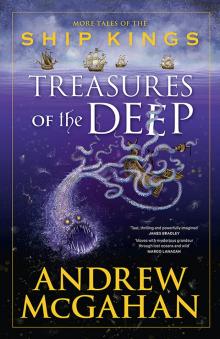 Treasures of the Deep
Treasures of the Deep The Rich Man’s House
The Rich Man’s House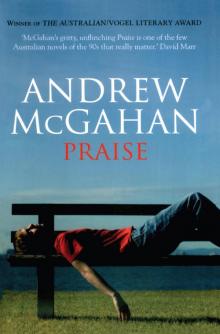 Praise
Praise The White Earth
The White Earth 1988
1988 The Coming of the Whirlpool
The Coming of the Whirlpool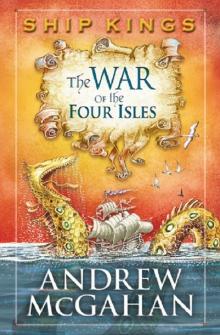 The War of the Four Isles
The War of the Four Isles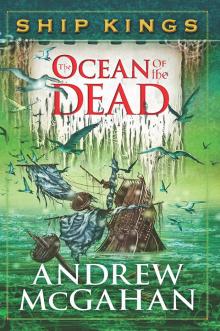 The Ocean of the Dead: Ship Kings 4
The Ocean of the Dead: Ship Kings 4 Last Drinks
Last Drinks Wonders of a Godless World
Wonders of a Godless World Underground
Underground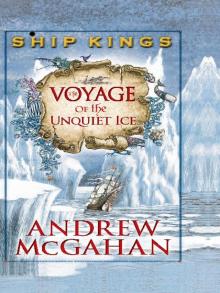 The Voyage of the Unquiet Ice
The Voyage of the Unquiet Ice